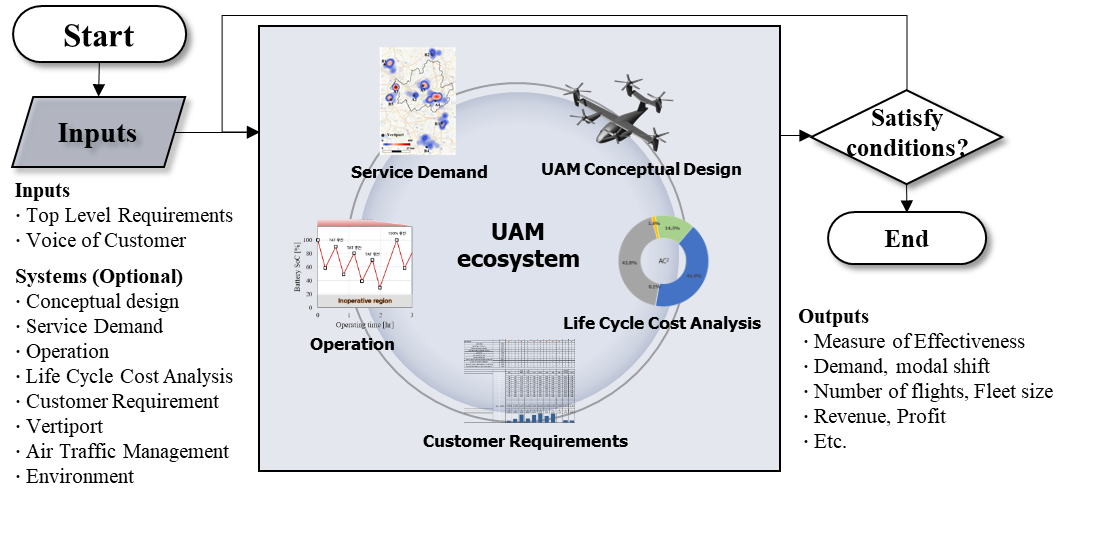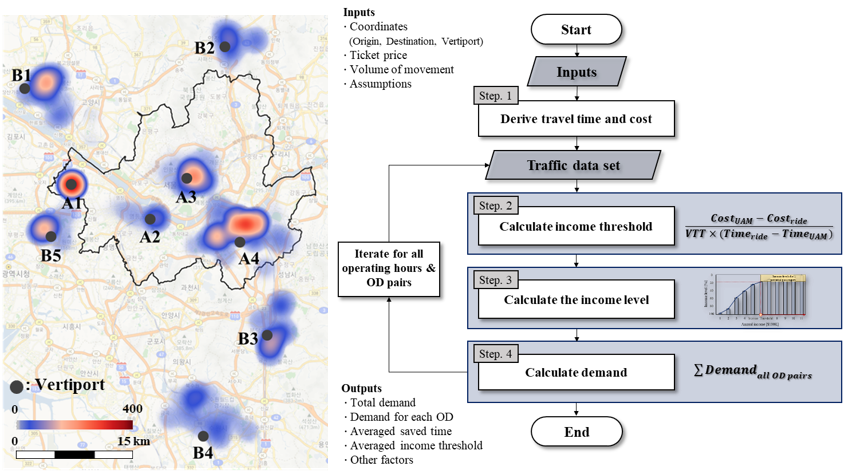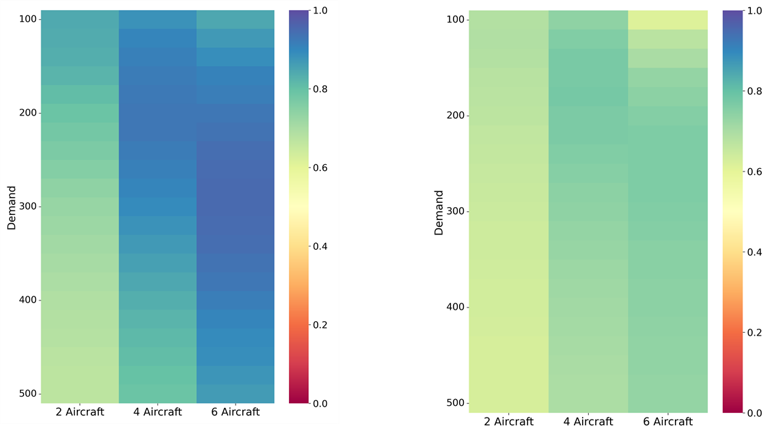UAM Ecosystem Framework
Multidisciplinary Analysis Design for Advanced Mobility
Urban Air Mobility (UAM) has emerged as a promising solution to urban congestion, drawing increasing attention as a next-generation transportation mode. While prior research has explored various technical and operational aspects, most studies remain fragmented, lacking a comprehensive, service-oriented perspective. This study adopts a holistic, multi-disciplinary approach to analyze the commercial viability of UAM services from an economic standpoint. By evaluating the complex interactions among system parameters and operational scenarios, the research aims to derive Top-Level Requirements (TLRs) that can inform both aircraft design and early-stage service strategies. The findings are intended to offer practical insights for UAM service operators, highlighting the importance of integrated analysis in shaping sustainable and scalable urban air mobility systems.

In this research, four core disciplines are considered:
1. UAM conceptual design and performance estimation
We utilize RISPECT+, an in-house conceptual design tool developed by our lab, to apply aircraft-specific characteristics to our simulations. For more details, please refer to the Aircraft System Design section.
2. Demand generation modeling based on urban characteristics [1]
Our lab also developed a demand estimation module tailored for UAM services. This module leverages the concept of an income threshold, which evaluates passengers' willingness to switch from conventional modes of transport to UAM. The method compares the time savings and additional costs of using UAM against a passenger's income level, effectively estimating the likelihood of modal shift. Using this methodology, we conducted demand forecasting for the Seoul metropolitan area.

3. Dispatching simulation for operational feasibility [2]
Based on the estimated demand and aircraft performance data, we conducted aircraft dispatching simulations. To efficiently explore a broader design space, we employed a Discrete Event Simulation (DES) framework. DES models the system's behavior as a sequence of discrete events over time and is one of the key analytical approaches for simulating the UAM ecosystem. Through this approach, metrics such as the total number of flights, deadhead flights, and transportation success rate are derived for given service settings.

4. Life cycle cost analysis [3,4]
Once daily averages of operational metrics (e.g., number of flights, transported demand) are obtained through the simulation, the operating cost of the UAM ecosystem can be evaluated. In this study, operating costs are categorized into six major components: Depreciation, Battery, Infrastructure, Pilot, Maintenance, and Management (IOC).
To estimate aircraft depreciation, we first calculate the acquisition cost of the vehicle. This is done by referencing the cost structures of hybrid general aviation aircraft and incorporating the unit costs of additional electric propulsion systems. For each seat-capacity configuration, aircraft acquisition costs are estimated using parameters such as gross weight, maximum motor output, and total battery capacity.

Heatmaps of system performance, based on the analyzed operational fleet size for each demand flow, are presented in Figure 10. These heatmaps visually depict system performance across various configurations of fleet size and seating capacity under both circulating and concentrating demand flows.

By interpreting these heatmaps, the optimal fleet size strategy for specific scenarios can be identified. For instance, in a circulating demand flow with a daily demand of 200 passengers, deploying four aircraft per vertiport emerges as the most favorable configuration for maximizing ecosystem performance. This visualization enables stakeholders to evaluate trade-offs between fleet size and demand flow type, supporting a systematic approach to determining the most effective operational configuration for achieving high system performance. [5]
Moreover, this method provides actionable insights for aligning fleet strategies with specific demand patterns and can be extended to include different seating capacities, further enhancing its applicability to diverse UAM scenarios.
Reference
[1] Kim, H., & Yee, K. (2023). Potential UAM demand forecast and analysis: application to Seoul metropolitan area. In AIAA AVIATION 2023 Forum (p. 4210).
[2] Lee, H., Kim, H., & Yee, K. (2024, October). Parametric analysis of Urban Air Mobility system considering vertiport and UAM performance. In Asia Pacific International Symposium On Aerospace Technology (APISAT 2024) (pp. 1947-1956). Adelaide, South Australia: Engineers Australia.
[3] Kim, H., Kim, H., Lim, D., & Yee, K. (2022). Development of a Multidisciplinary Design Framework for Urban Air Mobility. Journal of the Korean Society for Aeronautical & Space Sciences, 50(8), 583-590.
[4] Kim, H., & Yee, K. (2021). A novel cost estimation method for UAM eVTOLs. Journal of the Korean Society for Aeronautical & Space Sciences, 49(3), 233-241.
[5] Kim, H., Lee, H., & Yee, K. (2025). A Framework for Deriving Top-Level Requirements in UAM Ecosystem with System Performance Considerations. In AIAA SCITECH 2025 Forum (p. 2697).